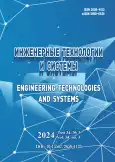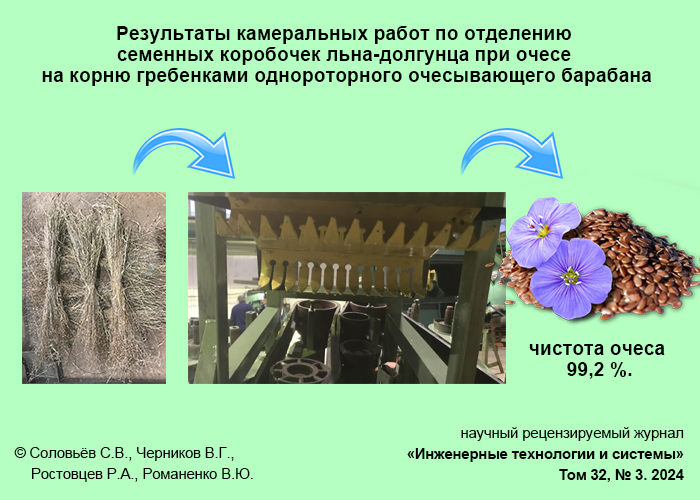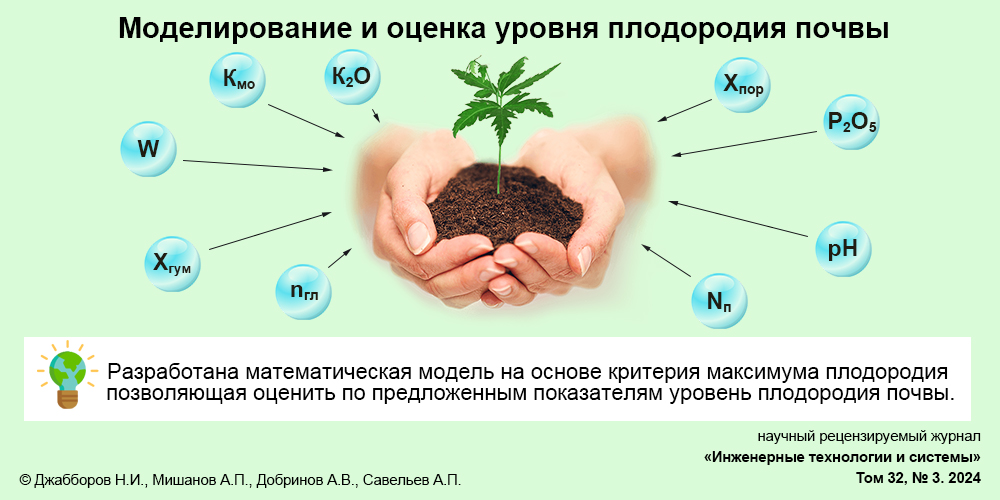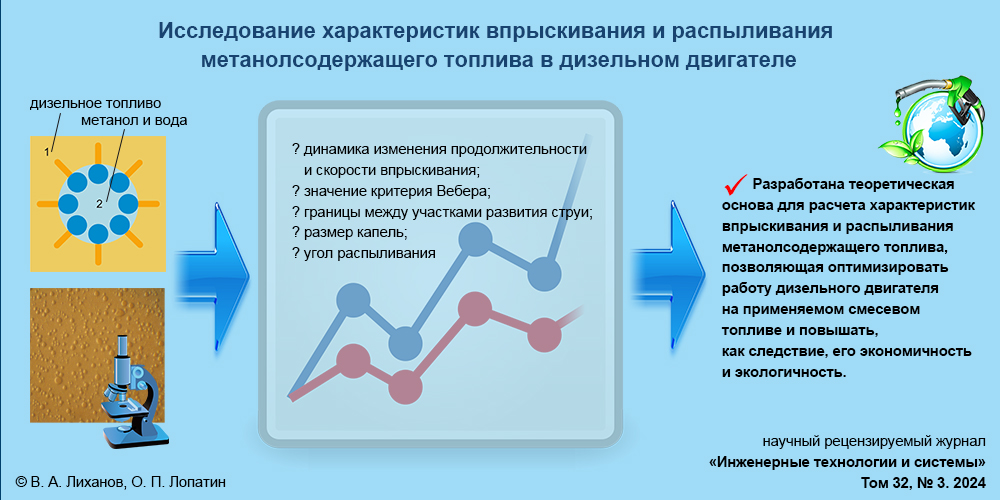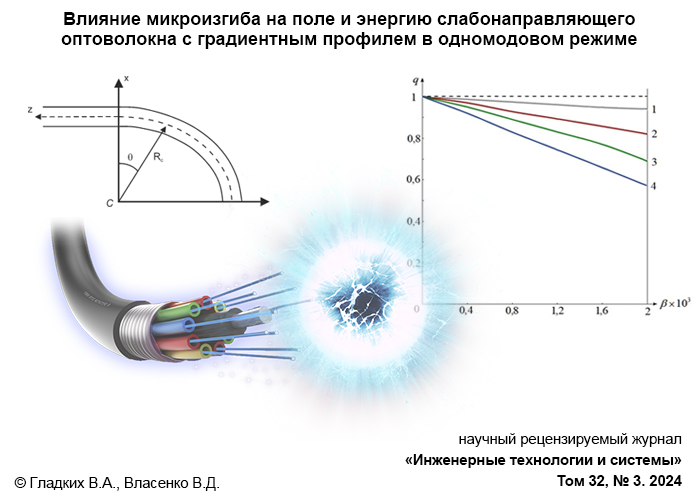Volume 34, Nº 3 (2024)
- Ano: 2024
- ##issue.datePublished##: 15.09.2024
- Artigos: 9
- URL: https://journals.rcsi.science/2658-4123/issue/view/16451
Edição completa
Technologies, Machinery and Equipment
The results of the laboratory study on the separating fiber flax seed balls when combing the standing plants with a single-rotor comb-dresser
Resumo
Introduction. The low purity of combing flax seed balls with flax harvesters is a problem for the technological operation when harvesting fibre flax. The analysis of the comb designs of the combing units made it possible to identify the main disadvantages that do not fully meet the agrotechnical requirements for harvesting fiber flax. An innovative design of a removable comb for single-rotor drum-type harvesters is proposed.
Aim of the Study. The study is aimed at determining the purity of combing the standing fiber flax stems using a single-rotor comb-dresser with removable combs.
Materials and Methods. There has been made an experimental setup to simulate the process of combing standing fiber flax plants with combs of a single-rotor comb dresser. During the period from 2018–2023, the design parameters and operating modes of the combing unit were investigated and justified. There has been developed a technique for conducting a multifactorial experiment to determine the purity of combing fiber flax using a combing drum-type unit with removable combs.
Results. The results of laboratory studies on the separating flax balls from the standing fiber flax stems by removable combs are presented to determine the combing quality. It has been found that the purity of combing fiber flax plants is up to 99.2%.
Discussion and Conclusion. When studying the technological process of combing Nadezhda standing fiber flax plants the with single-rotor drum removable combs, the physico-mechanical properties of the flax stems were studied in laboratory conditions, the optimal operating modes of the combing drum were determined, which ensure the purity of the stems above 98% that meets the agrotechnical requirements for flax combines.
 350-369
350-369


Separating light impurities from the combed heap in the adapter case
Resumo
Introduction. It is possible to increase the separating of loose grain on the lattice bottom of the combine harvester feeder house by removing most of the light impurities from the combed heap using an inertial cleaning system built into the combing adapter body.
Aim of the Study. The study is aimed at developing an inertial system for separating light impurities in the combing header body and optimizing its main parameters.
Materials and Methods. The object of the study was a large-scale model of a pneumatic cleaning device to simulate the motion of air and components of a combed grain heap inside the combing adapter body. It was a two-factor experiment with three variations of the air flow velocity (4.5; 5.5; 6.5 m/s) and the width of the air channel (0.26; 0.29; 0.32 m). The studies were conducted on a combed heap of Moskovskaya 56 wheat with a moisture content of about 12%. As a parameter for optimization and response function, a portion of the combed heap was selected from the body of the installation with an air flow.
Results. According to the results of the experimental studies, it was found that the air flow velocity has a greater effect on separating glumes than the width of the air channel. A simultaneous increase in both factors leads to an improved separation. At the same time, if increasing the air flow velocity ensures a stable increase in the proportion of the combed heap and is limited only by the air velocity at which grain appears in the combed heap along with the glumes, then changing the channel width allows achieving the parameter optimal value.
Discussion and Conclusions. The use of an inertial cleaning system makes it possible to remove almost completely light impurities from the combed heap. The optimal parameters of the device are: channel width 0.28...0.3 m, air flow velocity 6...6.5 m/s.
 370-387
370-387


The study of the process of supplying seeds of row crops using a vacuum seed-placing unit
Resumo
Introduction. The performance of precision seeders depends on many factors, including the functionality of their dosing systems, the modernization of which is possible only on the basis of patterns, which allows forecasting the indicators of single seed placing into a furrow.
Aim of the Study. The study is aimed at analyzing the influence of the diameter of the suction holes of seed-placing units and the rarefaction created in them on the characteristics of placing seeds of the main row crops.
Materials and Methods. The results of the study were obtained based on a series of experiments on sowing corn and sunflower seeds using an MS-8 seeder, the operation principle of which can be considered typical for vacuum seed-placing units.
Results. There have been obtained empirical dependences of the particular features of zero and group placing seeds of such row crops as corn and sunflower on the area of the suction holes and the rarefaction in the vacuum chamber.
Discussion and Conclusion. The quantitative estimates obtained may differ for seeds of the same crop, but having different technological properties. The general factor is that the frequency of missing seeds is proportional to the suction force magnitude in the working plane of the metering element, regardless of its area. At the same time, the probability of double seed placing depends on the area of the metering ports with a constant suction force, a decrease in their diameter leads to a decrease in the frequency of double seed placing. The data obtained allow considering joint variations in the magnitude of the rarefaction in the vacuum chamber and the diameter of the suction holes as effective tools for improving the seed placing quality.
 388-406
388-406


Modeling and assessment of soil fertility level
Resumo
Introduction. The relevance of the study is related to the problem of increasing soil fertility. The value of soil as the main means of agricultural production in a specific economic infrastructure is determined by its fertility that is its ability to satisfy the needs of specific plants for nutrients, water, and to provide the root system of plants with air and heat. The effectiveness of increasing soil fertility depends on objective soil assessments and forecasting. Therefore, mathematical modeling for the fertility level of soils for the agricultural production is an urgent task for agroengineering studies.
Aim of the Study. The study is aimed at developing a mathematical model for an integrated assessment of soil fertility levels.
Materials and Methods. When conducting the study, analytical methods were used and the results obtained by various authors on this problem were summarized. The object of the study was the published results of scientific researches by the authors from other scientific institutions obtained on the problem under consideration.
Results. Based on an analysis of the literature references, there was made a scientifically-based list of the most significant indicators for assessing soil fertility, which includes the content of organic matter (humus), acidity, humidity, soil porosity, presence of microorganisms and clay particles, content of mobile forms of nitrogen, phosphorus and exchangeable potassium. A mathematical model has been developed based on the criterion of maximum soil fertility, which makes it possible to assess the level of soil fertility using the proposed indicators.
Discussion and Conclusion. The examples of calculations based on average and basic values of indicators with the use of the proposed mathematical model are presented. They give an idea of the most typical procedures for generating indicators and assessing the process under consideration. The value of the fertility probabilistic coefficient LFs < 1 indicates soil depletion (degradation), which will not ensure an economically sound harvest. In this case, measures must be taken to increase soil fertility. When LFs > 1, the soil is fertile and is able to supply plants with nutrients, water and air for their growth and development. The soil fertility level is an important criterion for assessing the impact of agricultural technologies on environmental safety and the environment state.
 407-423
407-423


Agricultural Engineering
Investigating the characteristics of injecting and spraying methanol-containing fuel in a diesel engine
Resumo
Introduction. The operation of eco friendly and high-efficiency internal combustion engines is not possible without deep and comprehensive study of using new types of fuels. That is why, forecasting the indicators of injecting and spraying in a diesel engine running on a mixed alcohol-containing fuel, which have a direct effect on the combustion and formation of toxic components and, as a result, on efficiency and eco friendliness, is an urgent scientific task.
Aim of the Study. The study is aimed at developing a theoretical basis for calculating the characteristics of injecting and spraying methanol-containing fuel into diesel engine cylinders that allows optimizing its processes.
Materials and Methods. There are considered the characteristics of injecting and spraying alcohol-containing fuel in a diesel engine modified to operate on a mixed methanol-containing fuel. There were used the well-known A.S. Lyshevsky dependencies, which fairly reliably reflect the processes of injecting and spraying in diesel engines.
Results. The in-depth studies of the basic principles for evaluating the indicators of injecting and spraying standard fuel made it possible to adapt them for fuels of mixed methanol-containing composition and to investigate the dynamics of changes in the duration and speed of injection, the Weber criterion values, the boundaries between the areas of fuel jet forming, droplet size and spraying angle.
Discussion and Conclusion. There has been developed a theoretical basis for calculating the characteristics of injecting and spraying methanol-containing fuel that makes it possible to optimize the operation of a diesel engine running on mixed fuel and, as a result, improve its efficiency and eco friendliness. The presented numerically information on the change in the boundaries of the fuel jet forming areas, the size of the droplets and the angle of the spraying cone allows us to reliably determine the basic parameters of spraying of the used mixed methanol-containing fuels, determine the vector of optimization of the mixing processes and gives insight into the promising directions in designing the geometry of combustion chambers, intake ducts, etc.
 424-443
424-443


Flow structure and periodic processes in a disc-shaped vortex chamber of a hydrodynamic cavitator
Resumo
Introduction. The essence of the acoustic – cavitation processes is that the liquid is passed through sound with a pressure at the wave surface of more than 3 bar that causes local breaks of the liquid in the vacuum phase of the wave and the collapse in the manometric phase. The opposite walls of each cavern in the collapse approach at a speed exceeding two speed of sound, due to which a high energy density is achieved at the meeting point, and what is especially valuable is the mutual transitions of energies from one form to another, unattainable under normal conditions, and, moreover, as inside cavitation area and near it. The novelty of the work is confirmed by the results of a periodic information and patent analysis, and by four patents received for inventions on the topic under consideration.
Aim of the Study. The study is aimed at improving the acoustic-cavitation qualities of a disk-shaped vortex chamber used as a liquid whistle.
Materials and Methods. In the study, there were used numerical modeling of flows in the FlowVision program, experimental determination of flow rates using a pitot tube, film method, removal of frequency response using SpectraPLUS 5.0, and visualization of flows and processes on optically transparent devices by the method of color indicators in stroboscopic lighting high-speed video shooting.
Results. The mechanism of sound generation and noise in the flow transiting through the device has been found. The corrective effect of pump pulsations f = 300 Hz on the sound generation mechanism was revealed. The disc-shaped character of the device, which encloses the input flow in cross section from three directions, contributes to creating a more expressive acoustic signal, forming two conjugate torus vortices along the shell that ensures uniformity of the circumferential flow, attenuation of longitudinal high-frequency oscillations f = 200 kHz, and the creation of periodic zones of increased pressure along the shell. The concentrated tangential entrance to the device determines the central asymmetry of the flows in it and a number of processes that create acoustic noise.
Discussion and Conclusion. The frequency of the useful acoustic signal in the vortex chamber is proportional to the speed of the transit flow, and the amplitude is proportional to the dimensions of the device. Along with the useful signal created by the interaction of the peripheral and input parts of the transit flow, noise of similar frequencies is created in the device. Other sources of noise generation are due to the presence of a concentrated tangential input. The formation of two conjugate torus vortices along the shell can be used as a means of controlling the process of interaction between parts of the transit flow. The disc-shaped vortex chamber combines the functions of sound generation and the ability to create a centrifugal field, which expands its technological capabilities.
 444-460
444-460


Instruments and Methods of Experimental Physics
Critical parameters of the athermal electroplastic effect in metallic materials
Resumo
Introduction. Plastic deformation and electric current, acting separately, usually have opposite effects on the deformation behavior and flow stresses in electrically conductive materials. In the case of the combined action of plastic deformation and applied electric current, the result is not pre predictable. The study of the synergistic effect of deformation and electric current can be used for metal forming.
Aim of the Study. The study is aimed at demonstrating the existence of impulse current threshold parameters at which the athermal electroplastic effect manifests itself in various materials.
Materials and Methods. Tensile tests were performed at various current modes, which exclude the increased contribution of the thermal effect to the reduction of flow stresses – current density and duty cycle. The fractographic features of the fracture surface were studied using raster scanning microscopy. There were found the threshold values of current parameters at which stress jumps associated with the electroplastic effect occur.
Results. The influence of the density and duty cycle of the impulse current on the manifestation of the electroplastic effect is shown. Both parameters have threshold values, above which the electroplastic effect becomes observable (at density j > jкр ) or athermal (at duty cycle Q > Qкр). All types of tension are accompanied by a viscous fracture and void formation, which is most intensively formed, when current is injected.
Discussion and Conclusion. In alloys with low electrical resistance, the threshold impulse current density corresponding to the occurrence of the electroplastic effect is higher than in alloys with high electrical resistance. Increasing the duty cycle of the impulse current reduces the temperature of the deformed sample that allows considering the electroplastic effect as athermal.
 461-473
461-473


Thermal energy resource potentials of the Kara-Bogaz-Gol Gulf as a “solar pond”
Resumo
Introduction. The use of environmentally-friendly engineering systems including solar energy technologies makes it possible to reduce energy costs and therefore to lower production costs and anthropogenic stress on the environment.
Aim of the Study. The authors used innovative techniques to assess the thermal resource potential of solar radiation, to analyze the salt deposits of the Kara-Bogaz-Gol Gulf as thermal accumulators for the development, introduction and use of solar thermal technologies and to justify the technical and economic feasibility of their use in engineering systems in the Kara-Bogaz-Gol Gulf (Caspian region).
Meterials and Methods. The study design is based on systematic theoretical calculations of the gross, technical, economic and ecological potentials of solar radiation taking into account environmental conditions. For calculating there were used the methods of mathematical modeling of heat and mass transfer processes in active solar energy systems when converting solar energy into thermal energy in the salty reservoir of the Kara-Bogaz-Gol Gulf as a “solar pond”.
Results. There have been assessed the solar energy characteristics for the introduction of various engineering storage systems and technologies. There have been determined the results of energy storage on the reservoir salt surface during the day: in winter – 1 009.0 W/m2 per day, in summer – 1 574.7 W/m2 per day. It has been proven that the potential of solar energy conversion into thermal energy varies from 40 to 70% depending on the season. Aaccording to theoretical calculations, the solar pond efficiency in winter is 11.4% and in summer – 14.6%. In summer, there was measured the average temperature on the salt surface of the reservoir bottom, it ranges from 55.04 to 79.8 ºC, in winter from 20.0 to 25.6 ºC.
Discussion and Conclusion. The results obtained can be used for strengthening energy security, developing energy systems and producing autonomous thermal power devices based on solar energy that will reduce the energy consumption of fossil fuels and improve the environmental situation in the region. The materials of the article can be used in preparing design estimates and feasibility study for developing various solar energy systems and technologies in the Caspian region.
 474-494
474-494


Optics
Micro-bending effect on the field and energy of weakly guiding optical fiber with a gradient profile in single-mode regime
Resumo
Introduction. Optical fibers are widely used for high-bandwidth transmitting communication signals over long distances. The key feature enabling this performance is signal low attenuation, that is signals experience minimal power loss propagating along the optical fiber. One of the factors influencing power loss during information transmission is the fiber bending. Bending can increase the signal transmission power loss of an optical fiber because of both macrobending and microbending. Studying the dependence of signal power losses when bending on waveguide parameters makes it possible to control the signal power losses of an optical fiber during information transmission.
Aim of the Study. The study ia aimed at evaluating the effect of microbending on the field and energy of a weakly guiding optical fiber with a gradient refractive index profile in a single-mode regime.
Materials and Methods. From the equations for the fields of straight and curved sections of weakly guiding fiber for an arbitrary gradient profile of the refractive index with the help of the subsequent solution of inhomogeneous Helmholtz equations by the Green’s function method, there were obtained expressions for relative energy: the ratio of the field energy of the fiber curved section to the field energy of the fiber straight section (in the first approximation for a single-mode regime).
Results. The obtained expression for the relative energy depends on two parameters: the waveguide parameter and the ratio of the optical fiber radius to the radius of curvature. For the quadratic case of a power-law profile, as the closest to the actually used one, numerical calculations were used to construct the dependences of the relative energy on the parameter characterizing the bending for different values of the waveguide
parameter.
Discussion and Conclusion. It has been shown that in the case of microbending, the longer the wavelength or the smaller the fiber radius, the lower the losses. The results obtained can be used in calculating optical fiber profiles designed to operate in a bent state and eliminate expensive experimental modeling of light guides and in designing waveguides to solve specific applications, in particular, to increase energy efficiency, reliability and performance of the measuring instruments.
 495-515
495-515








